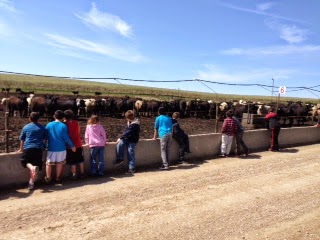Have you ever walked beans?
Have you ever heard of walking beans?
I smile as I ask this because before I became a farmer I had no idea
what walking beans meant. Before I was
married I had a co-worker at a vet clinic I worked at that farmed with her husband. One day she mentioned that she was going to
be walking beans on her weekend off. At
that time I knew very little about farming and farming terminology. The little bubble above my head was of her
and a leash and somehow getting green beans to move along. I didn’t even know that she was referring to
soybeans as the only fields I saw growing up were cornfields.
 |
| I am walking through a soybean field just as the leaves are beginning to turn. The plants are knee high. |
My flashback to that moment came the other night as I was
watching TV and one of the political candidates from Iowa mentioned that she
had grown up walking beans. I was
wondering how many people knew what she was talking about. I also realized I’ve done this when talking
to people about what we do on our farm.
I assume someone understands my terminology until I see a confused look
on their face or worse yet, they turn and walk away shaking their head!
One of those expressions came to me when I was talking about
how we treat cattle. When we find a sick
animal we remove him from his pen and take him up to the barn where we can give
him medicine. This is how I said it “we
pull the steer and then take him to the barn to get treated”. I didn’t realize that the bubble image the
person was having was of us roping the animal and dragging him from the pen to
the barn. Fortunately this person asked
more questions so I was able to explain what “pulling” meant.
 |
| We use ATV's instead of horses to remove cattle from their pen. We try to walk them out slowly as this steer is doing. He is looking at the gate and moving towards it. |
I wasn’t brave enough to ask my friend what it meant to walk
beans. My opportunity to learn came when
I became a farmer. When Steve and I
were in our early years of marriage I became quite skilled at walking
beans. Walking beans was a form of weed
control in soybean fields. We would walk
through the rows with a hoe to cut out the weeds. My sisters also became skilled at walking
beans when they came to visit. We all agreed
that walking beans was not that fun but easier than detasseling corn.
 |
| The soybean plant with numerous little pods growing along the stem. |
 | |
| Here is a part of a soybean plant with a few pods. The quarter gives you an idea of the size of the pod and beans inside. |
My days of walking beans are long over thanks to the
development of roundup ready soybeans.
Using a chemical to control weeds isn’t the only tool we use but this
was a big help. Tillage methods and crop
rotation are also important as we try to raise the best crop we can each
year.
I would encourage anyone not familiar with farming
terminology to ask the questions that help in understanding what we are doing
and why. My own fear of looking stupid
really makes me look stupid for not asking and making an inaccurate
assumption. I have learned to prefer wisdom over ignorance, facts over fear and truth over lies.
 |
| Happy Fall from our house to yours! |
“Ask and it will be given to you; seek and you will find;
knock and the door will be opened to you! For everyone who asks,
receives; and the one who seeks, finds; and to the one who knocks, the door
will be opened.” Matthew 7:7-8



















